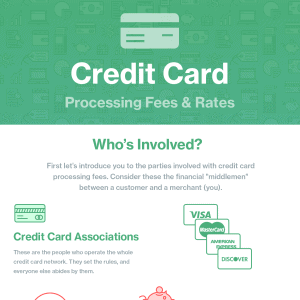Flat-rate processing keeps costs simple, making it a smart fit for new and very small businesses
Our content reflects the editorial opinions of our experts. While our site makes money through
referral partnerships, we only partner with companies that meet our standards for quality, as outlined in our independent
rating and scoring system.
Flat-rate credit card processing makes it easy to accept payments. Instead of juggling multiple fees for different card types, you’ll pay one consistent transaction fee for each type of sale.
In this guide, we’ll cover how flat-rate pricing works, what it costs, and when it makes sense for your business.
What Is Flat-Rate Credit Card Processing?
With flat-rate pricing, all costs — interchange fees, network fees, and some processing fees — are rolled into a single rate. You’ll pay the same fee for all transactions of the same type, whether a Visa, Mastercard, or other card is used.
Flat rate pricing is:
- One flat fee per transaction type
- Simple and predictable
- Usually offered month-to-month
Flat rate pricing isn’t:
- A single universal rate for every transaction
- Always cheaper than interchange-plus pricing
You may pay different flat rates for in-person vs. online transactions, but each rate is consistent within its category.
How Flat-Rate Card Processing Works
Flat-rate processing combines all fees into a single, simplified transaction fee. Typical rates look like this:
| Transaction Type |
Rate |
| Card-present (swipe, dip, tap) |
2.6% + $0.10 |
| Card-not-present (online, keyed-in) |
2.9% + $0.30 |
Here’s what this would look like in practice:
- $20 in-person transaction at 2.6% + $0.10 = $0.62 fee
- $20 online transaction at 2.9% + $0.30 = $0.88 fee
Which Payment Processors Use Flat-Rate Pricing?
Flat-rate credit card processing is most common with third-party payment processors, also called “payment service providers.” These processors typically don’t charge monthly fees and rely on transaction fees to run their business.
Some popular flat-rate processors include:
Most flat-rate processors are third-party providers. But if you want a full-service merchant account, National Processing is one of the few that offers flat-rate pricing.
What’s Included In Your Flat-Rate Fee?
Most flat-rate processors include:
- Transaction costs
- PCI compliance
- Account maintenance
- Fraud monitoring
- Some supporting software
- Gateway fees
You may still pay extra for:
- International transactions
- Currency conversion
- Advanced features or software
- Chargebacks & refunds
Flat-rate processors usually offer month-to-month contracts, so you can switch providers anytime without early termination fees.
Average Flat-Fee Processing Rates
At the time of this update, flat-rate fees range from 2.6% to 3.5% on the variable side and between $0.05 to $0.50 on the fixed fee side.
Card-present transactions (including swiped, dipped, and tapped transactions) tend to skew toward the lower end of these ranges, while online and keyed-in transactions represent the higher end of these ranges.
Are Flat-Rate Merchant Services Cheaper?
Flat-rate pricing is often more expensive than interchange-plus pricing per transaction. You’re paying for simplicity and predictability, not just the card swipe.
Here’s how it breaks down:
| Works Best For |
Not Cost-Effective For |
| Low-volume businesses |
Large corporations |
| Seasonal businesses |
High-volume merchants |
| Freelancers |
Businesses processing $5,000+/month |
| New businesses |
Subscription-based businesses |
When To Use Flat-Rate Processing
Flat-rate processing can make sense if you:
- Own a very small or new business
- Run a side gig or seasonal business
- Want a predictable, easy-to-understand fee
- Prefer to avoid monthly account fees
Flat-rate pricing eliminates most merchant account fees, and the month-to-month setup makes it easy to switch to a full-service merchant account when your business grows.
Whether you stick with flat-rate pricing or explore other models, check out our picks for the best credit card processors for small businesses to find your best fit.












